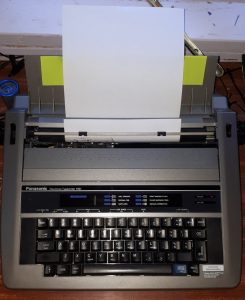Since I started using Scrivener for my novels I can’t imagine life without it. I almost live in it. But as indispensable as it is, it does have one major drawback — it shares my laptop with a browser. Even though I use the wonderful composition mode, it doesn’t quite make Scrivener distraction free. It isn’t Scrivener’s fault of course, the same applies to Word or ZenWriter or whatever software you use. I’ll just be getting into the zone, half way through some wonderful dialogue, when a little warble grabs my attention. Someone has tweeted! Or it will be a bleep to tell me I have new mail. Just as when you hear the snap of your letterbox followed by the thud of post landing on your mat, you are unable to resist these cues. You should ignore them and continue with what you were doing but you can’t. Your curiosity gnaws at you, so you have to look and see what wonder has dragged you away from your writing. Ah. Someone you don’t know is informing you that they are having an awesome cup of coffee. Or it’s another link to a funny cat video on YouTube that you can’t resist having a peek at, even though you know you will spend the next hour watching other funny cat videos. Or it’s another spam email. In other words, nothing that will change your life has just happened. And now you have lost your train of thought and that brilliant dialogue has suddenly dried up.
Even whilst I was writing that first paragraph I had two tweet warbles. I resisted, this time. Yes I could mute the sound, but then I could miss other system sounds that are actually quite useful. I could fiddle about tinkering with notification settings, but that is another distraction in itself. Then there is the issue of editing. Scrivener is wonderful for editing your writing. You can move things around and chop and change to your heart’s content. The trouble is, it is far too tempting to do that as you go along. It is far better to keep your momentum going and just write, write, write. Edit later.
So that got me thinking. How authors used to work seemed quite logical. They’d sit at a typewriter and bash out one page at a time until they had a big pile of pages that they could go and sit in a comfy chair and edit with a pencil. I remembered I had an electric typewriter still sitting in a cupboard, so I went and retrieved it. And guess what? It still worked. Instantly. There was no waiting for anything to load. I could just start typing. The words flowed, it was joyous. I could see those words magically appearing on a physical sheet of paper in front of my eyes. There was no internet to distract me. Suddenly I felt like a writer again. It was a revelation. I was able to grab a coffee and sit back to look through those pages and write little notes and corrections in the margins. It all felt just so much easier.
There is one mental hurdle to get over with this approach — you know that you need to get your writing into Scrivener or Word at some point. That will mean typing it all again. No, don’t shout scanning and OCR at me. That’s a tedious and unreliable process that needs lots of correction itself. It is easier to just re-type everything. The trick is not to see this as a chore but an opportunity. Think of the typewriting stage as the first draft. Then, when you type it into your computer it is the second draft. You will have made lots of comments and alterations as you read through it and you will be making the necessary corrections and changes as you go along. So your Scrivener file will already be the second draft and you will be that much closer to the finished product. Yes, you will be back on your computer at that point and open to distractions again but the point is you will hopefully only be tweaking by this stage and the major creative work will have been done on the trusty old typewriter. All I can say is, if you have one lying around somewhere go and dust it off and give it a try. You may just find, like I did, that it is a wonderful way to escape the beeps and warbles of modern life.
